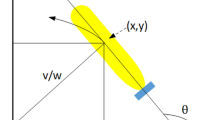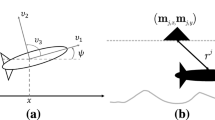Abstract
Terrain-referenced navigation (TRN) uses topographic data to correct drift errors due to dead-reckoning or inertial navigation. While it has long been applied to aerial vehicle applications, TRN can be more useful for navigation in underwater environments where global positioning system signals are not available. TRN requires a geometric description of undulating terrain surface as a mathematical function or a look-up table, which leads to a nonlinear estimation problem. In this study, three nonlinear filter algorithms for underwater TRN are considered: 1) extended Kalman filter, 2) particle filter, and 3) Rao-Blackwellized particle filter. The performance of these three filters is compared through navigation simulations with actual bathymetry data.
Similar content being viewed by others
References
J. P. Golden, “Terrain contour matching (TERCOM): a cruise missile guidance aid,” Proc. of 24th Annual Technical Symposium, International Society for Optics and Photonics, pp. 10–18, 1980.
L. Hostetler and R. Andreas, “Nonlinear Kalman filtering techniques for terrain-aided navigation,” IEEE Transactions on Automatic Control, vol. 28, no. 3, pp. 315–323, 1983.
D. Boozer, M. Lau, and J. Fellerhoff, “AFTI/F16 terrainaided navigation system,” Proc. of National Aerospace and Electronic Conference, Dayton, OH, USA, 1985.
A. Robins, “Recent developments in the TERPROM integrated navigation system,” Proceedings of the 44th Annual Meeting, Annapolis, Maryland, 1988.
M. Sistiaga, J. Opderbecke, M. Aldon, and V. Rigaud, “Map based underwater navigation using a multibeam echosounder,” OCEANS’98 Conference Proceedings, vol. 2, IEEE, pp. 747–751, 1998.
I. Nygren and M. Jansson, “Terrain navigation for underwater vehicles using the correlator method,” IEEE Journal of Oceanic Engineering, vol. 29, no. 3, pp. 906–915, 2004.
J. Carlstrom and I. Nygren, “Terrain navigation of the Swedish AUV62F vehicle,” Proc. of Int. Symp. Unmanned Untethered Submersible Technol., Durham, NH, 2005.
D. K. Meduna, S. M. Rock, and R. McEwen, “Low-cost terrain relative navigation for long-range AUVs,” Proc. of OCEANS 2008, IEEE, pp. 1–7, 2008.
C. Morice, S. Veres, and S. McPhail, “Terrain referencing for autonomous navigation of underwater vehicles,” Proc. of Oceans 2009-Europe, IEEE, pp. 1–7, 2009.
K. B. Anonsen and O. K. Hagen, “An analysis of realtime terrain aided navigation results from a HUGIN AUV,” Proc. of OCEANS 2010, IEEE, pp. 1–9, 2010.
O. K. Hagen, K. B. Anonsen, and M. Mandt, “The HUGIN real-time terrain navigation system,” Proc. of OCEANS 2010, IEEE, pp. 1–7, 2010.
F. Teixeira, A. Pascoal, and P. Maurya, “A novel particle filter formulation with application to terrain-aided navigation,” Proc. of IFAC Workshop on Navigation, Guidance and Control of Underwater Vehicles (NGCUV 2012), Porto, Portugal, pp. 10–12, 2012.
F. L. Lewis and F. Lewis, Optimal Estimation: With an Introduction to Stochastic Control Theory, Wiley New York et al., 1986.
Y. Bar-Shalom, X. R. Li, and T. Kirubarajan, Estimation with Applications to Tracking and Nnavigation: Theory Algorithms and Software, John Wiley & Sons, 2004.
M. S. Arulampalam, S. Maskell, N. Gordon, and T. Clapp, “A tutorial on particle filters for online nonlinear/non-Gaussian Bayesian tracking,” IEEE Transactions on Signal Processing, vol. 50, no. 2, pp. 174–188, 2002.
S. Thrun, W. Burgard, D. Fox et al., Probabilistic Robotics, vol. 1, MIT press Cambridge, 2005.
J. Kim and T. Kim, “Terrain-based localization using particle filter for underwater navigation,” International Journal of Ocean Engineering, vol. 1, no. 2, pp. 90–95, 2011.
J. Kim, S. Vaddi, P. Menon, and E. Ohlmeyer, “Comparison between nonlinear filtering techniques for spiraling ballistic missile state estimation,” IEEE Transactions on Aerospace and Electronic Systems, vol. 48, no. 1, pp. 313–328, 2012.
T. Kim, J. Kim, and H.-T. Choi, “Terrain-referenced Underwater Navigation using Rao-Blackwellized Particle Filter,” Journal of Institute of Control, Robotics and Systems, vol. 19, no. 8, pp. 682–687, 2013.
T. Kim and J. Kim, “Nonlinear filtering for terrainreferenced underwater navigation with an acoustic altimeter,” Proc. of OCEANS 2014-TAIPEI, IEEE, pp. 1–6, 2014.
J. W. Langelaan, “State estimation for autonomous flight in cluttered environments,” Journal of Guidance, Control, and Ddynamics, vol. 30, no. 5, pp. 1414–1426, 2007.
A. Gelb, Applied Optimal Estimation, The MIT Press, 1974.
Z. Khan, T. Balch, and F. Dellaert, “A Rao-Blackwellized particle filter for eigentracking,” Proceedings of t IEEE Computer Society Conference on Computer Vision and Pattern Recognition (CVPR 2004), vol. 2, pp. II-980, IEEE, 2004.
T. Schon, F. Gustafsson, and P.-J. Nordlund, “Marginalized particle filters for mixed linear/nonlinear state-space models,” IEEE Transactions on Signal Processing, vol. 53, no. 7, pp. 2279–2289, 2005.
H. Gustaf, K. Rickard, and G. Fredrik, “The Rao-Blackwellized particle filter: a filter bank implementation,” EURASIP Journal on Advances in Signal Processing, vol. 2010.
A. P. Aguiar and J. P. Hespanha, “Trajectory-tracking and path-following of underactuated autonomous vehicles with parametric modeling uncertainty,” IEEE Transactions on Automatic Control, vol. 52, no. 8, pp. 1362–1379, 2007.
N. Sun, Y. Fang, H. Chen, and B. Lu, “Amplitude-saturated nonlinear output feedback antiswing control for underactuated cranes with double-pendulum cargo dynamics,” IEEE Transactions on Industrial Electronics, vol. 64, no. 3, pp. 2135–2146, 2017.
N. Sun, Y. Fang, H. Chen, Y. Fu, and B. Lu, “Nonlinear stabilizing control for ship-mounted cranes with ship roll and heave movements: design, analysis, and experiments,” IEEE Transactions on Systems, Man, and Cybernetics: Systems, 2017.
Author information
Authors and Affiliations
Corresponding author
Additional information
Recommended by Associate Editor Yangmin Li under the direction of Editor Fuchun Sun. This work was supported by a fundamental research project (UD140040FD) of the Korean Agency for Defense Development (ADD) and a grant-in-aid of Hanwha Systems. We are grateful to Dr. Yosup Park, Korea Institute of Ocean Science and Technology, for providing the high-resolution bathymetric data.
Taeyun Kim received his B.S. degree in Mechanical Engineering and his M.S. degree in the Division of Ocean Systems Engineering from Korea Advanced Institute of Science and Technology (KAIST), Daejeon, Korea, in 2010 and 2012, respectively. He is currently a Ph.D. candidate in the Department of Mechanical Engineering at KAIST. His current research interests include vehicle navigation in GPS-denied environments and terrain-referenced underwater navigation.
Jinwhan Kim received his B.S. and M.S. degrees in naval architecture and ocean engineering from Seoul National University, Seoul, Korea, in 1993 and 1995, respectively, and his M.S. and Ph.D. degrees in aeronautics and astronautics from Stanford University, Stanford, CA, USA, in 2002 and 2007, respectively. He was a Full- Time Researcher with Korea Institute of Machinery and Materials and subsequently with Korea Ocean Research and Development Institute. He was a Research Scientist with Optimal Synthesis Inc., Los Altos, CA, USA. In 2010, he joined the Faculty with the Korea Advanced Institue of Science and Technology, Daejeon, Korea. His research interests include robotics and the guidance, control, and estimation of dynamical systems. Dr. Kim is a Senior Member of AIAA.
Seung-Woo Byun received his B.S. and M.S. degrees in Ocean Information & System Engineering from Jeju National University, in 2003 and 2007, respectively. He received his Ph.D. in Material Engineering from Korea Maritime and Ocean University in 2015. Since 2010, he has been a Senior Engineer at Hanwha Systems Co., Ltd. He has been working in the area of unmanned maritime system. His research interests include system engineering, mechanical design, modeling, and control of unmanned maritime vehicles.
Rights and permissions
About this article
Cite this article
Kim, T., Kim, J. & Byun, SW. A Comparison of Nonlinear Filter Algorithms for Terrain-referenced Underwater Navigation. Int. J. Control Autom. Syst. 16, 2977–2989 (2018). https://doi.org/10.1007/s12555-017-0504-5
Received:
Revised:
Accepted:
Published:
Issue Date:
DOI: https://doi.org/10.1007/s12555-017-0504-5




